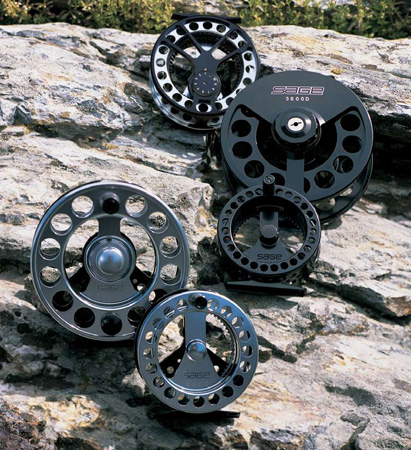Reels

Manufacturers also have an abundance of quality reels on the market. The basic reel types feature regular arbor spools or wide arbor spools with either a pawl drag or disc drag system.
The spool circumference of a regular arbor reel decreases rapidly as a fish takes out the line. This loss of line and decrease in the reel’s circumference creates a corresponding increase in drag pressure. Loss of line and loss of circumference translate into a loss of leverage. In other words, as the spool’s diameter shrinks, the drag tension increases. In addition, the weight of the extended line in the water increases the force and pull on a fighting fish. These forces can be an advantage because they naturally and smoothly increase the drag tension on a fighting fish. You don’t have to fiddle with the reel’s drag adjustment, although this increase in drag may break a light tippet. If you’re using a heavy tippet, however, this tension increase aids in slowing down an active fish. Nevertheless, the smaller circumferences of regular sized arbor reels make them slow at retrieving line. Slow retrieval speed can create a slack line and become downright cumbersome if a fish swims rapidly towards you.
Wide arbor reels lessen this natural increase in tension because their spool circumferences are bigger. This size increase in circumference results in a decrease in drag tension as the fish takes out line, always an advantage when fishing light tippets. A

wide arbor reel experiences fewer changes in drag tension as the line and backing leave the spool. The net result is a stable drag tension. Furthermore, the wide arbor reel retrieves line much faster than a regular sized arbor reel. As a fish runs towards you, you can better keep up with it and retrieve the slack line.
Wide arbor reels weigh more than regular arbor reels and the heavier weight can off-set the balance of the rod and reel, making the outfit “reel heavy.” This added weight can become annoying after a long day of fishing. A wide arbor reel also has less room to hold backing.
When fishing for larger fish with heavy tippets, I prefer a regular arbor reel although large arbor reels do a better job of protecting light tippets.
A pawl drag system is designed to keep a light tension on the reel spool and to prevent the spool from overrunning and backlashing. Pawl drag systems, however, lack a wide range of heavy drag settings, but they are nevertheless adequate for most freshwater fishing conditions.
Disc drag systems, by contrast, have a wide range of heavy drag adjustments; consequently, they excel when heavy pressure must be applied. Flyfishers use disc drag reels for the larger freshwater and all saltwater fish species. Because disc drag reels must be precisely engineered to maintain a smooth and constant pressure at heavy settings, these reels cost more and weigh more than pawl drag reels.

© 2025 The Gale Group, Inc. All rights reserved.
© 2025 Perigee Learning LLC. All rights reserved.
LoveTheOutdoors.com is owned and operated by Advameg, Inc. © 2025 Advameg, Inc.
Camping Adventures • Dutch Oven Cooking • Sports Knots
Fly Tying • Freshwater Fishing • Fly Fishing

